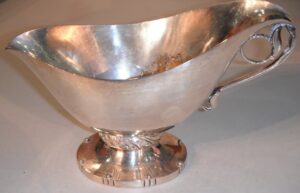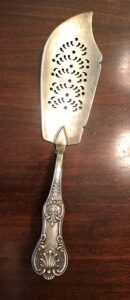When it comes to silver in its many forms—teapots, necklaces, trays, Native American concha belts, flatware, candlesticks, etc.—you need to know about the material and the top 3 silver marks in order to spot a valuable piece. There are three important marks that any silver collector, buyer or seller need to know. These marks will speak volumes about any piece of silver that you come across.
What are the Marks?
There are many marks used to identify and evaluate silver. And some of the marks on silver pieces ranging from sugar bowls to chandelier earrings are marked with a silver mark and have no silver content. None. The commonly used list of silver marks are many and they range from objects that have high quality and those that have no silver content whatsoever. Common marks on silver include Sterling or 925 which are two common fineness marks that are well known and others. Learn more about sterling silver.
Another common silver mark is coin silver which is a mark that states that an object is made up of an alloy of silver and copper with 90% silver and 10% copper. This measurement of silver is used on most US coins, hence the name. You may see numbers on a piece of silver like 800 or 900 which are also fineness marks indicating the amount of pure silver content in a piece. More about 800 and 900 marks coming up.
The most common marks on silver make up a long list but there are three marks that you should keep looking for. After the many other marks associated with silver, these three marks are the most important: a fineness or quality mark, a maker’s mark, and a location or country mark.
Where are the Marks?

How do I find one of the top 3 silver marks on my piece of silver? I field this question often. Sometimes it is difficult to find the silver mark on an object. On serving pieces or accessories, marks are not too difficult to find but on jewelry pieces silver marks may be hidden or very difficult to find. Here’s where to look.
On serving pieces like silver trays supporting multi-piece tea sets or candlesticks, marks are typically found on the underside of the object, on the bottom edge or side edge, and near lips or edges. Sometimes the marks are clear and plain such as a quality or fineness mark like “Sterling” or a maker’s mark such as “Gorham” or “International Silver”. Other times, a piece of silver may host a hallmark or pictograph image to suggest a maker’s mark, date stamp, or fineness mark.
On jewelry, it is a whole other story when it comes to where to look for silver marks. Based on the style, design, and size of a piece of jewelry, you may need to get out your magnifying loupe or magnifying glass in order to see the silver mark. Typically, when looking for a silver mark on a piece of jewelry, that mark may be found on a clasp, flat edge of a piece, back of a piece, or interior section of the piece of jewelry. Marks on rings may be found on the edge of the ring or on the interior. Some bracelets are marked on their clasp or inconspicuously on their underside or back. Finding a silver mark can be tricky. Learn more about silver jewelry marks.
Top 3 Silver Marks
Here are the three marks that you should find on your piece of silver:
1. Fineness or Quality Mark
This is the mark that tells you how much silver content is included in your item. Some items like teapots, creamers, sugar bowls, and trays may have marks showing the amount of troy ounces of the piece. That measurement tells a buyer a good deal about the quality of a piece of silver. Some other pieces may show its silver content by parts per 1000 of pure silver such as 800, 900, 925 which equates to 80%, 90%, or 92.5% pure silver. This is a more commonly used marking system for jewelry pieces or silver purse handles, etc. Such a fineness mark is typically marked onto a piece inconspicuously.
2. Maker’s Mark
Maker’s marks can be straightforward with the entire name of the maker or designer marked on the piece. Some maker’s mark can be monograms or initials of the firm to indicate the maker. On some pieces, the maker’s mark can be a pictograph representing a maker, designer, or firm. A pictograph is a pictorial symbol for a word, phrase, or name. Some firms like Swarovski use their company logo, a swan, to represent their company on a piece of silver jewelry or giftware. The most common combination of silver marks is the fineness and maker’s mark group which can be found on many pieces of silver. This is easy to find and provides the most necessary information about the piece.
3. Location or Country Mark
The location, country mark or country of origin mark on a silver piece is very important. It is a mark that tells the story of where a piece came from or where it originated. This mark tells the buyer about the origin of a piece of silver and where it was made. Commonly silver pieces are made in Italy or Mexico and other countries. In most cases, these location or country marks are clearly marked on a piece of silver.
More Silver Marks
Some pieces of silver may have additional marks such as AG, the symbol for silver from the periodic table of elements, or a distributor’s mark like the store where a piece is sold such as Tiffany & Company and a designer’s name which may not be the same as the maker’s mark. Sometimes a designer designs a piece for maker and they have different marks. In this case, the maker’s mark would typically be added to the piece and the designer’s mark may or may not be found on a piece of silver.
The three marks – fineness, maker’s, and location/country mark–are the top 3 silver marks that you need to know to spot a good piece. However, there are other marks that regularly show up on silver pieces that should sound an alarm. These are the marks that indicate fineness or lack thereof even though there is little or no silver content in the marked piece.
Look alike but not Silver Marks
German silver, Nickel silver, and Alpacca (or Alpaca) are marks used on pieces that look like silver but have no silver content whatsoever. German silver and Nickel silver are common marks and the properties of a German or Nickel silver include a silver white colored alloy of zinc, copper, and nickel.
These three alloys—German silver, Nickel silver and Alpacca–are combinations of nickel, copper, tin, and zinc. Alpacca employs all of these metals where as German silver and Nickel silver do not combine tin with the other metals. German silver and Nickel silver are more commonly used in Europe and America and Alpacca is a useful alloy commonly found in the markets of silver colored objects in Mexico, Central America, and South America. Alpacca pieces are typically a dull silvery grey color and like German silver and Nickel silver, they are not worth as much as pieces made of actual silver.
Widely used, these other marks suggest a silver by color and texture but they have no silver content.
Electroplated Silver Marks
Lastly, the very common marks that may be found on all types of pieces of a silver color and feel include EPNS for electroplated nickel silver, Silver over Copper which is a mark found on many early 20th Century pieces, and EPC which stands for electroplated copper. These marks and a few others all demonstrate that a piece has been silver plated using the electroplating process.
When it comes to evaluating a marked piece of silver, look for the following value indicators in addition to the marks:
Weight of the piece will indicate how much fine silver material that the piece possesses. This could be measured by troy ounces for some objects. The heavier the piece, often the more valuable the piece when it comes to a piece of silver.
Quality materials reference the fineness of a piece of silver jewelry or another type of silver object. Quality always drives the market.
Complexity of design is a well-known value indicator and one which shows how comfortable a maker or designer is working with a material such as silver. It can highlight a maker’s or designer’s ability or level of mastery of his/her craft. If a design in silver is complex, the piece probably is worth more based on the look or design of the piece in addition to fineness and other factors.
As with any vintage or antiques object or piece of jewelry, the familiarity, fame, and status of the maker and/or designer can impact value also. If a piece is designed or made by a famous maker or designer, then the market allows a seller to command a higher price for such a piece of silver giftware, houseware, or jewelry. When a maker or designer has achieved a high status in the market based on his/her previous works then the value of his/her more recent works can rise.
You can show me your silver items to be appraised by scheduling a video call or you can send me photos.
Watch videos on my YouTube channel as I show you how to identify the top 3 silver marks to tell value.
Read More »




